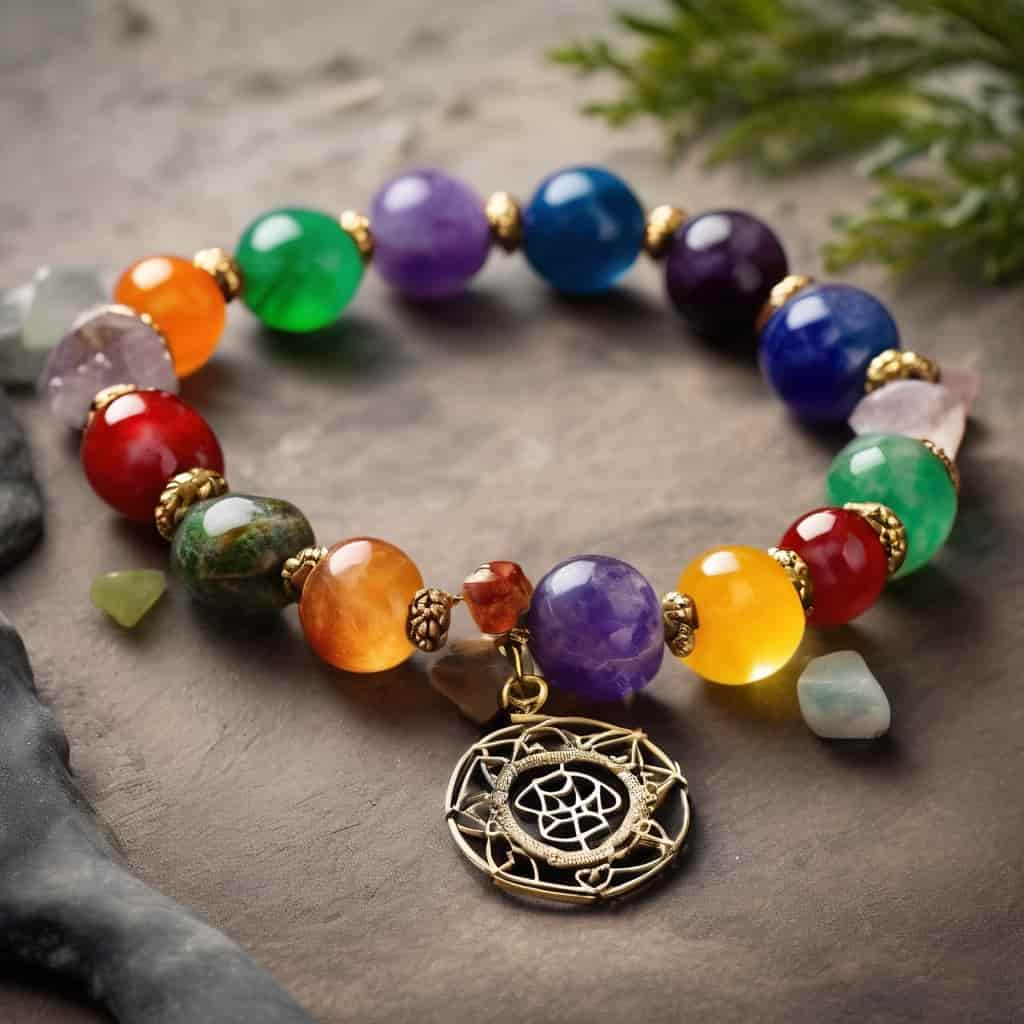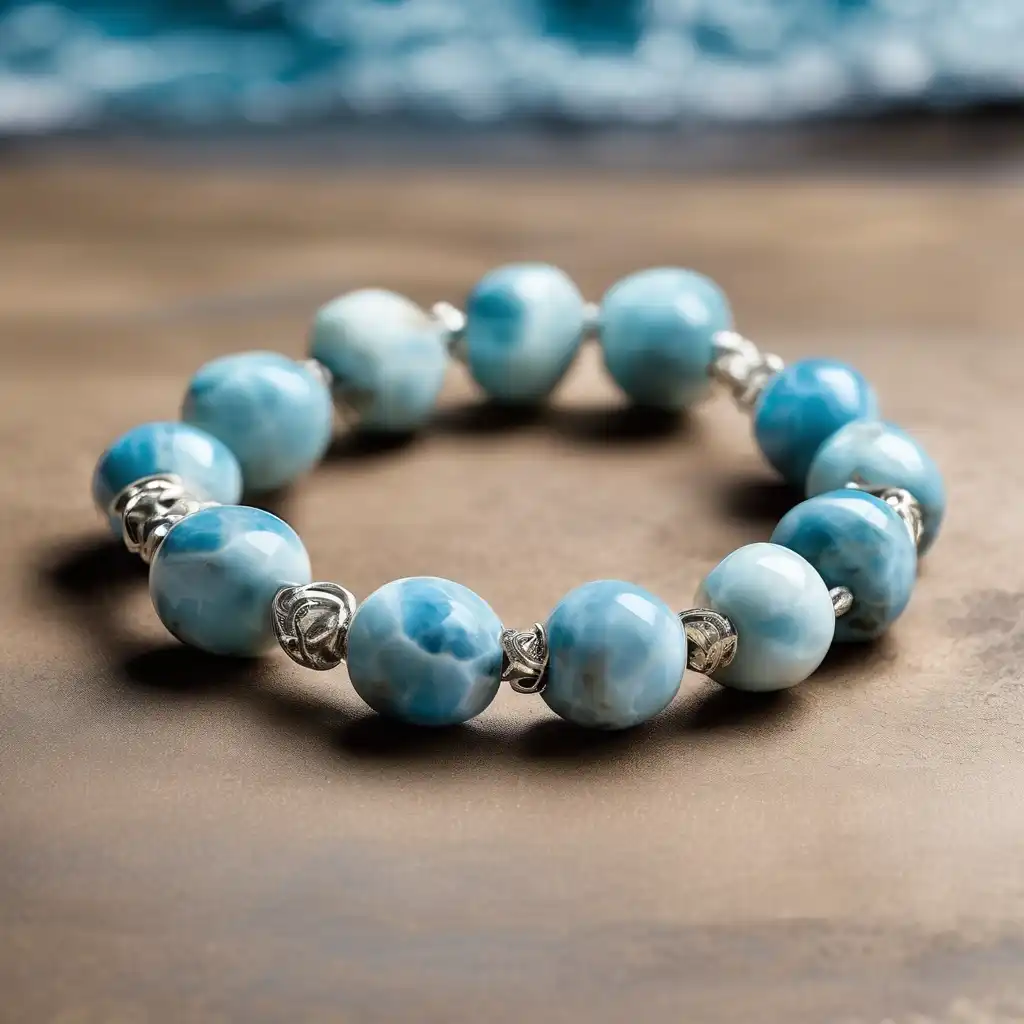Kambaba Jasper Meaning: Unearthing the True Identity of This Mysterious Stone
What Is Kambaba Jasper, Really?
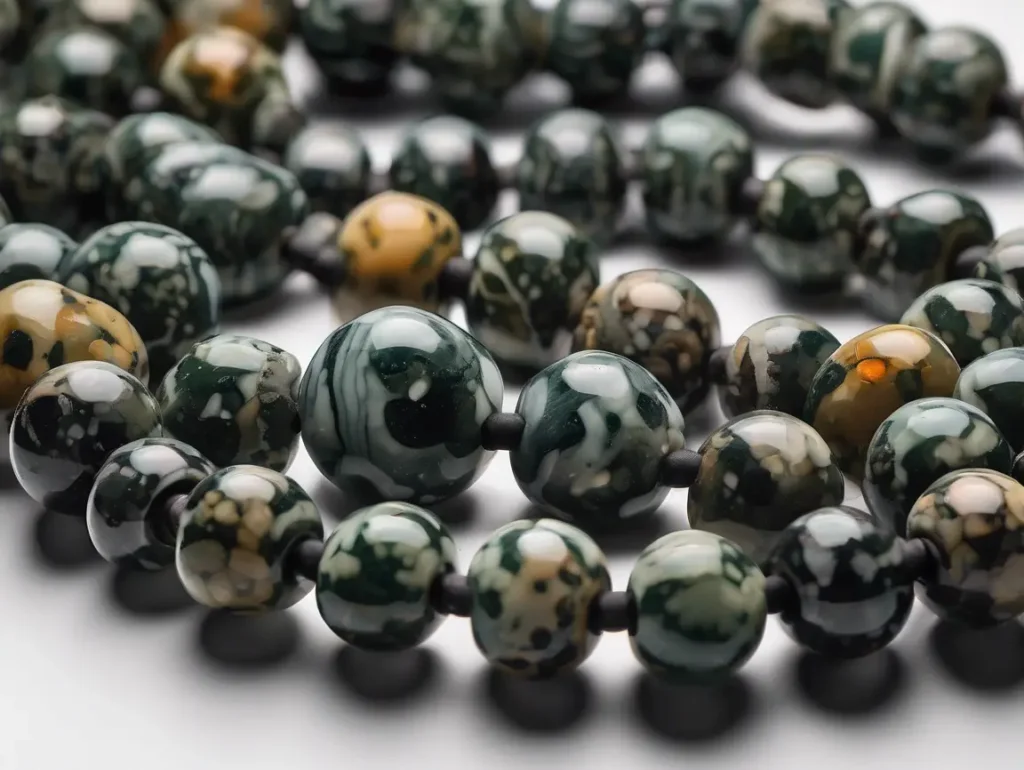
Kambaba Jasper is one of those stones that immediately catch your eye—dark green swirls, black orbs, and an ancient look that seems to whisper stories from the Earth’s deepest layers. But beyond the first glance, the real kambaba jasper meaning isn’t just about aesthetics—it’s about mystery, mislabeling, and energy that people across the world claim to feel when they wear it.
Despite its widespread marketing as a jasper type, Kambaba Jasper is not actually jasper. For many years, it was believed to be a stromatolite fossil—a layered structure formed by ancient cyanobacteria. The idea that you could wear 3-billion-year-old fossilized life forms on your wrist was compelling, and the stone gained traction among collectors, healers, and energy enthusiasts.
Then, a study emerged, upending the preconceived notions about this stone.
The EPI-Lab Revelation: Not a Fossil, Not a Jasper
In a widely discussed analysis, Germany’s EPI-Lab (Edelstein Prüflabor) examined samples of Kambaba Jasper sourced from Madagascar. Their conclusion? It’s neither a stromatolite nor a jasper.
What the lab found was that the stone is actually a rhyolitic volcanic rock, with no fossilized biological material. It’s a type of igneous rock formed by volcanic activity, and its orbicular patterns are mineralogical, not organic. This reclassification led to a flurry of debates in the gemstone community. But rather than diminish its popularity, it gave the stone a new kind of intrigue. If it’s not fossilized bacteria, what is it?
So, if we go strictly by science, the kambaba jasper meaning changes from “ancient biological lifeform” to “volcanic mystery with hypnotic orbs.” But energetically, its reputation remains untouched.
Why the Name “Kambaba”?
The word “Kambaba” itself adds another layer of uncertainty. It doesn’t have a clear geological or linguistic root, and it doesn’t appear to come from any formally recognized African language. It is, however, believed to be loosely inspired by a regional name in Madagascar, where the stone is still heavily mined.
What’s interesting is that in crystal healing communities, the name has taken on its identity—Kambaba is now synonymous with tranquility, grounding, and ancient Earth wisdom. So, while the etymology is unclear, the spiritual branding is strong.
The Global Demand for Kambaba Jasper
Despite the geology debate, demand for Kambaba Jasper keeps climbing—especially in Western boutiques. In cities like Portland, Berlin, and Barcelona, bracelets rarely stay in the case for long. Retail partners report that the 4 mm, 6 mm, 8 mm, and 10 mm strands vanish first because shoppers love layering different sizes for texture and depth.
One Berlin buyer even joked the beads are “Lego for grown-ups—mix, match, build your mood.” Customers who return for a second or third bracelet almost always mention the same thing: the stone’s steady, grounding presence.
A London yoga teacher calls her bracelet “a pocket jungle that slows my breath,” while an Austin software engineer says it gives him “just enough quiet focus to push through deadline chaos.” Dozens of similar stories echo across review pages; whether people describe a gentle magnetic pull or a simple calming weight, the consensus is clear—Kambaba Jasper helps them stay centered when life speeds up.
It’s also important to note the diversity of products made from this stone. Beyond bracelets, Kambaba Jasper is crafted into:
- Faceted pendulums for divination and spiritual alignment
- Ball pendulums used in Reiki and energy healing
- Loose strand beads, favored by artisans for custom jewelry
- Tumbled stones, which people carry in their pockets or place on altars
- Rough stones, often used in home décor or gridding
- Heart-shaped pieces are symbolic of emotional healing work.
Each of these forms allows the wearer or user to connect with the kambaba jasper meaning in a way that feels personal and intentional. Whether someone’s seeking peace, spiritual grounding, or just a powerful visual accent, Kambaba Jasper delivers both energetically and aesthetically.
Why the Real Meaning Still Matters
Why is this important—why should we be concerned whether it’s a fossil, a rhyolite, or even a misnamed jasper?
In the realm of crystals, significance extends beyond mere scientific understanding. It’s emotion, experience, and belief. People don’t just buy Kambaba Jasper because it’s beautiful (although it absolutely is). They buy it because they feel something when they touch it. They wear it and sleep better. They hold it during meditation and feel calmer. They gift it to friends going through challenging times.
And that’s where the true kambaba jasper meaning lies—not just in its mineral structure, but in the lives it touches and the energy it carries forward.
What Does Properties Kambaba Jasper Look Like?
The Signature Look: Deep Green with Mysterious Orbs
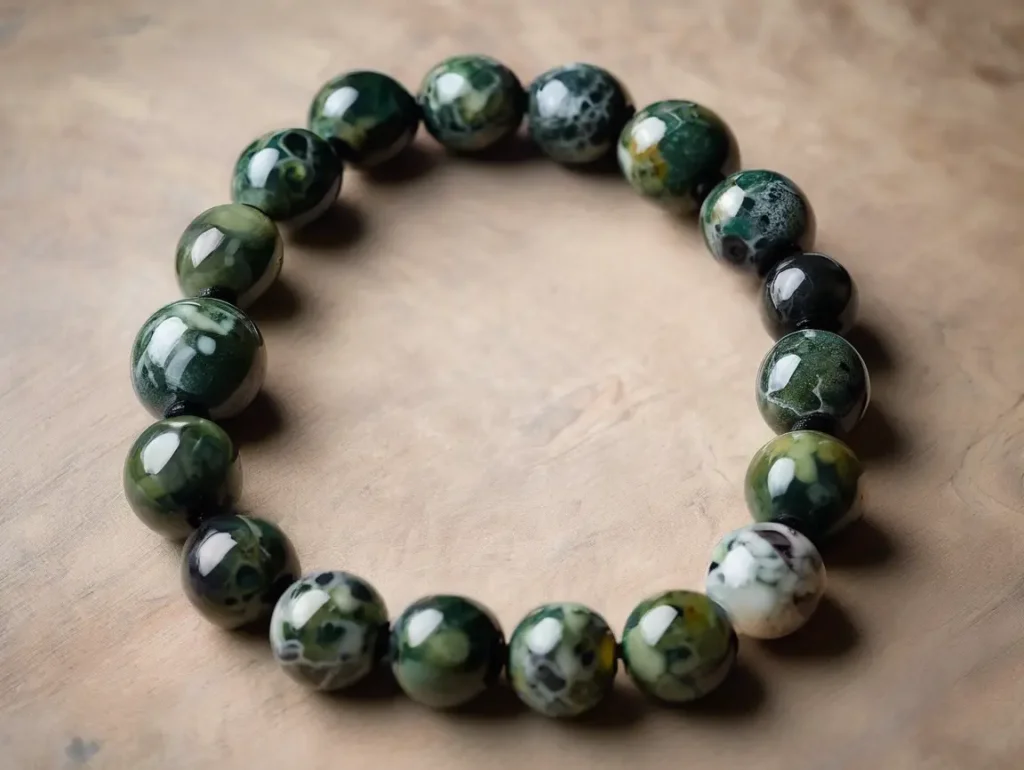
Kambaba Jasper has an unmistakable visual presence—once you’ve seen it, you remember it. At first glance, it looks like something pulled from an ancient jungle floor: swirling shades of mossy green, dark forest tones, and clusters of round, black orbs that give it a deeply organic, almost primeval feel. Some say it resembles crocodile skin. Others compare it to fossilized algae under a microscope. Either way, it’s a stone that stands apart from other green minerals, and that uniqueness plays a big role in how people connect with the kambaba jasper meanings.
Those circular orbs are actually mineral formations, not fossils—though the visual similarity to ancient lifeforms has fueled years of misidentification. The interplay between the green matrix and darker spheres gives the stone depth and texture that can’t be replicated with dyed stones or synthetic materials. This unique visual identity strongly supports the calming, grounding kambaba jasper meaning that many users describe after wearing or holding the stone.
From Rough to Refined: The Many Faces of Kambaba Jasper
Raw kambaba isn’t always pretty when it first comes out of the ground. It often looks like a dull green-gray lump. But once it’s cut, shaped, and polished, its beauty comes alive. Lapidaries and crystal artisans have transformed this material into a wide range of styles—each format revealing a different facet of the stone’s visual charm and metaphysical potential.
Here are just a few of the most common forms you’ll find:
- Tumbled Stones are Palm-sized, smooth, and perfect for pocket carrying or altar use.
- Bracelets (4mm–10mm beads) – Extremely popular in Western markets. These are by far the best-selling format for energy wear.
- Faceted Pendulums – Used for dowsing, meditation, and intuitive guidance. The clean-cut faces reflect light beautifully.
- Ball Pendulums —often seen in Reiki practice or chakra balancing. Their symmetrical shape offers a calming energy flow.
- Loose Strand Beads – Ideal for jewelry makers looking to design custom mala necklaces or multi-strand bracelets.
- Rough chunks—still uncut, great for collectors or display pieces.
- Heart Shapes are Symbolic and decorative, often used in love or forgiveness rituals.
Each of these shapes lets users connect with the kambaba jasper meaning in different ways. A bracelet brings its grounding energy close to the skin all day long. A faceted pendulum may be reserved for spiritual rituals. A tumbled piece on your desk can serve as a visual and energetic anchor during a stressful workday. Whether it’s worn, carried, or placed around your space, the stone offers multiple ways to interact with its healing potential.
For artisans, every bracelet or pendulum they carve captures a slightly different kambaba jasper meaning, making each piece feel truly one-of-a-kind.
Texture, Hardness, and Durability
Visually striking as it is, Kambaba Jasper is also practical. It scores between 6.5 and 7 on the Mohs scale, making it hard enough for everyday wear yet soft enough to be carved and shaped with relative ease. Its surface has a smooth, almost waxy feel when polished, with a luster that ranges from vitreous (glass-like) to silky, depending on the finish.
This level of hardness means you can wear it as a bracelet or carry it in your pocket without worrying about immediate damage. However, it’s still advisable to store it separately from harder stones like quartz or topaz, which could scratch it over time. And while it’s water-safe for casual exposure, regular soaking or saltwater immersion may degrade the polish over time.
Is Kambaba Jasper Safe to Use?
This is a common concern among those new to crystal healing. The short answer is yes—Kambaba Jasper is not toxic, and there are no harmful metals or reactive minerals in its composition. Still, if you’re planning to use it in gem elixirs or water rituals, make sure you’re following safe infusion practices. Most people prefer to connect with the kambaba jasper meaning through direct contact—holding the stone during meditation, wearing it as jewelry, or placing it near their heart while resting.
So whether you meditate, stack bracelets, or simply keep a stone on your desk, you’re engaging with the core kambaba jasper meaning—grounding energy that lets the mind breathe.
How Its Appearance Supports Its Meaning
One of the reasons the kambaba jasper meaning resonates with so many is because its appearance aligns so perfectly with what people feel energetically. The green tones speak to healing, nature, and emotional balance. The swirling orb patterns seem to reflect the cycles of life, harmony, and timeless wisdom. These visual clues help users reinforce their intention when working with the stone. For many, it’s not just a lovely rock—it’s a visual reminder to slow down, breathe, and reconnect with what really matters.
Kambaba Jasper and the Quiet Inside
When the World Gets Loud

Commuter horns, Slack pings, and tomorrow’s to-do list often leave most of us starting the day with already frazzled nerves. That’s usually when the kambaba jasper meaning shows up in conversation among people who keep the stone close. A photographer friend in Seattle told me he rubs a small palm stone between shots so he doesn’t forget to breathe. My sister keeps a bead in her coat pocket for subway rides; she says the green swirls feel like “a tiny forest that fits in my hand.”
Stories like these are everywhere: no chanting, no incense—just an ordinary moment made steadier by something weighty and cool against the skin. And that, in a sentence, is the everyday kambaba jasper meaning—not lofty mysticism, but a handhold when the volume of life turns up too high.
What Does It Do to the Heart and Root?
Healers like to place Kambaba Jasper on the chest first and the tailbone second. The aim is simple: let the heart open without floating away. The stone’s deep jungle greens echo the color palette of the heart chakra, while its volcanic ancestry plants the energy firmly in the root. People who try this “two-point” layout often describe a sensation like heavy blankets on a winter night—secure yet expansive.
That tactile comfort is part of why the kambaba jasper meaning always circles back to balance: emotional release in the chest, practical footing in the feet. Even outside a therapy room, you’ll notice similar language. A Dublin barista told me her bracelet “keeps my temper behind the counter” during the morning rush. A retiree in Toronto said it helps him “feel the floor” during tai chi. Different continents, same verdict: the stone links tenderness with backbone.
Protection Without the Armor
Traditional protective stones—obsidian, hematite—often feel blunt, almost combative. Kambaba Jasper works differently. Users say it builds a quiet perimeter rather than a hard shield, like closing a door softly instead of slamming it. One social worker I met in Austin leaves a tumbled piece on her desk; clients seldom notice it, but she swears the room stays calmer. Her experience matches dozens of reviews that frame the kambaba jasper meaning as a “buffer zone” rather than a barrier. Even those with a scientific mindset may dismiss this as a placebo, but they acknowledge that the presence of the stone causes their shoulders to relax. Placebo or not, tension released is tension released—another tick in the stone’s favor.
Small Rituals, Big Shifts
Because the kambaba jasper meaning centers on subtle steadiness, the stone slides easily into daily routines. Writers park a pebble beside their keyboard before tackling a tricky paragraph. Breathwork coaches instruct students to rest a heart-shaped piece on the sternum for six slow inhales. Some marathoners tape a tiny cabochon under their racing bib as a reminder to pace themselves. None of these acts require classes or certifications; they’re everyday hacks that borrow the stone’s grounding vibe and give it a job to do. Over weeks and months, those micro-rituals add up to a visible shift in demeanor—the same shift that keeps customers ordering new bracelets in 4-, 6-, 8-, and 10-millimeter sizes.
Why People Keep Reaching for It
Plenty of crystals advertise calm or courage, but few carry both an ancient backstory and a look that seems alive under bright light. That blend locks the kambaba jasper meaning into memory. You don’t forget the crocodile-skin pattern, and you don’t forget how your jaw unclenched the first time you held it. So people come back—yoga moms, software engineers, touring bassists—each weaving the stone into ordinary life in their own unflashy way. And every time they do, the definition of kambaba jasper meaning grows less textbook, more personal: a split second of silence between breaths, a green thread running through a hectic day, evidence that even in a noisy century, stillness can be pocket-sized and portable.
What Are the Benefits of Wearing Kambaba Jasper?
A Quiet Presence That Travels With You
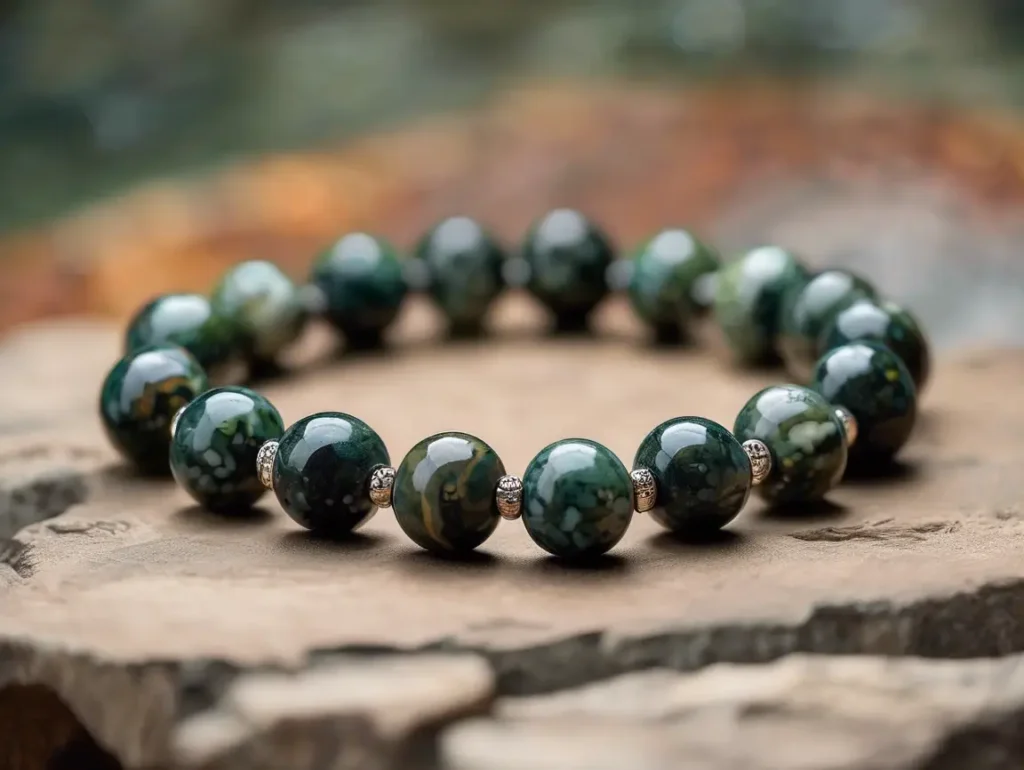
People wear crystals for different reasons—some for beauty, others for belief—but those who keep reaching for Kambaba Jasper usually describe something subtler. They don’t claim instant miracles. They discuss how they stop clenching their jaws in meetings or how tension eases before they realize it. That kind of shift is what the kambaba jasper meaning often comes down to: a slow, steady grounding that meets you where you are.
In the U.S. and across Europe, demand for Kambaba Jasper bracelets has grown rapidly. Customers love the natural variation in its swirling greens, but more than that, they love how the stone makes them feel. Beads sized 4mm, 6mm, 8mm, and 10mm each have their following—smaller ones for layering, larger ones for bold energy. Some say their bracelet acts like a buffer between themselves and a tense environment. Others feel it reminds them to pause, breathe, and reset.
That’s where the kambaba jasper meaning gets personal. It’s not just a label from a gem book—it’s tied to a feeling people return to again and again.
The Physical Echo of Emotional Calm
Although science hasn’t fully explored crystal energy, it’s hard to ignore the physical benefits people attribute to wearing this stone. Many say their sleep improves. Others report fewer tension headaches or less restlessness during long workdays. In crystal healing circles, the kambaba jasper meaning is often linked to the regulation of nervous energy—especially for people who live on high alert or in sensory overload.
One ICU nurse in Munich described her experience this way: “After 12 hours in full gear, I used to feel like I was vibrating with stress. Now, if I catch myself spinning out, I touch the bracelet, and something shifts.” That “something” may be unprovable, but it’s meaningful enough to keep her wearing it daily.
Wearing the Stone Strengthens the Connection
There’s a difference between carrying a stone in your pocket and wearing it against your skin all day. Many people believe that the constant skin contact enhances the effects of the stone. In the case of Kambaba Jasper, which is often associated with both the heart and root chakras, a bracelet sits right in that energetic flow zone. And so, the kambaba jasper meaning becomes more than theoretical—it becomes habitual. You don’t need to think about grounding—you feel it while typing, walking, or even brushing your teeth.
It’s the repetitive contact, that tiny sense of weight, that turns a stone into a tool. Over time, many users find that the bracelet doesn’t just calm them—it teaches them to stay calm.
Style Meets Substance
A huge part of why people enjoy wearing Kambaba Jasper is that it looks good with nearly everything. The mossy greens and circular black patterns are earthy but striking. Whether someone’s style is minimalist, mystical, or corporate, the stone fits in. Some customers combine it with lava beads to diffuse calming oils. Others pair it with rose quartz or obsidian to balance emotional intensity.
Regardless of the pairing, the kambaba jasper meaning holds the role of stabilizer. In chaotic combinations, it grounds. In soft pairings, it anchors. Its ability to make people feel good is why it stays on wrists and close to skin, but its versatility in jewelry is also appealing.
Why People Rarely Take It Off
For many, a Kambaba Jasper bracelet starts as a curiosity and becomes a constant. It’s not flashy, and it doesn’t advertise its purpose—but it delivers. After a while, people don’t want to leave the house without it. That’s the thing about the kambaba jasper meaning—it grows with you. You wear it through deadlines, flights, awkward conversations, and long walks home. It collects your stories, and in a strange way, it holds them.
Ask long-time wearers why they keep it on, and they rarely talk about metaphysics. Instead, they say things like: “I just feel off when I forget it.” Or, “It’s part of my rhythm now.” That’s what makes this stone more than an accessory. It becomes a quiet, grounding companion—always there, always steady—and that is the most honest expression of the kambaba jasper meaning you’ll find.
What Is Kambaba Jasper For?
A Stone That Grows With Your Intentions
People often ask what Kambaba Jasper is really for. Is it for stress? For energy? Is it for spiritual growth? The beauty of the kambaba jasper meaning is that it doesn’t demand a fixed definition. Some use it to settle their nerves before public speaking. Others wear it for focus during work or meditation. And for many, it’s simply there—a familiar, grounding presence woven into their daily rhythm.
Unlike stones that seem tailored for a single task, Kambaba Jasper works like a steady partner. Its benefits build over time, and the relationship between wearer and stone deepens through repeated use. That’s why the kambaba jasper meaning is often described as evolving—something you live into, rather than memorize from a crystal guidebook.
Zodiac Synergy: Who Feels It Most
While anyone can benefit from wearing Kambaba Jasper, the stone has a unique resonance with Cancer and Capricorn. Cancers, often ruled by emotional tides, appreciate the stone’s calm and containment—it acts like an anchor in turbulent moments. Capricorns, driven and self-disciplined, connect with its invitation to slow down, breathe, and allow themselves to soften.
Astrologers suggest it’s well-suited to both water and earth signs, but even those who don’t follow horoscopes find that the kambaba jasper meaning touches on something primal. The stone evokes a sense of holding—energetically grounded, emotionally supported, and spiritually shielded. People of all temperaments and beliefs have worn the stone and later said, “I didn’t expect to feel anything. But I did.”
Kambaba Jasper vs. Rhyolite: Close Cousins, Different Vibes
The confusion is understandable—both stones are volcanic, both are patterned, and both have rich greens in their palette. But when it comes to vibe, they part ways. Rhyolite pulses with outward momentum. Its energy inspires movement, creativity, and exploration. Kambaba Jasper, on the other hand, draws you inward.
The kambaba jasper meaning revolves around internal stillness. Where Rhyolite says, “Get going,” Kambaba Jasper whispers, “You’re already enough.” Sit with it.” The orb-like structures in Kambaba Jasper create a visual rhythm that mirrors its energetic rhythm—stable, layered, reliable. It calms without numbing you and grounds you without dragging you down.
Kambaba Jasper vs. Nebula Stone: Earth vs. Cosmos
Another common point of confusion is Nebula Stone. Both are dark green, dotted, and mysterious. But Nebula Stone—despite being visually cosmic—pulls your awareness outward, into the stars, into “higher realms.” People use it for intuition and expansion.
By contrast, the kambaba jasper meaning returns you to your own body. Its energy doesn’t lift you out—it helps you land. People who work with both stones often say Nebula is for exploring the unknown, while Kambaba is for making peace with where you are now. The night sky and the forest floor are both quiet, but one takes you home and the other far.
An Anchor in All Stages of Life
What makes this stone truly valuable is that it doesn’t expire. Teenagers use it to reduce anxiety. New parents carry it to survive sleepless nights. Elders rest it near their pillows for deeper reflection. The kambaba jasper meaning adapts to your chapter, your pace, and your story.
Over time, it absorbs your rhythms. It knows the feel of your hands, the weight of your emotions. You don’t outgrow it. If anything, you grow with it. That’s why longtime wearers often say they’d feel strange without it—it becomes part of their energetic signature.
The kambaba jasper meaning, at its most refined, isn’t about escaping the world or ascending to something higher. It’s about becoming more fully rooted in who you are—and knowing that’s enough.
Frequently Asked Questions About Kambaba Jasper
Is Kambaba Jasper safe to wear all day?
Yes, it’s completely safe to wear Kambaba Jasper continuously. It scores between 6.5 and 7 on the Mohs scale, making it durable enough for daily use. Many people feel that long-term contact enhances the calming effects, which ties directly into the kambaba jasper meaning of slow, steady grounding over time.
How do I cleanse and recharge my Kambaba Jasper?
You can cleanse it with running water, moonlight, or sound. Some prefer to bury it in soil overnight. However you recharge it, the idea is to return the stone to its natural rhythm—something deeply tied to the kambaba jasper meaning, which is all about reconnecting to the Earth.
Can Kambaba Jasper go in water or sunlight?
Brief contact with water is fine, but prolonged soaking may dull its polish. Sunlight is safe, but not necessary. Its energy doesn’t need amplification through extremes, which again reflects the kambaba jasper meaning—gentle, not forceful.
What’s the best way to use it for stress or anxiety?
Most users find that wearing a bracelet or carrying a tumbled stone during work, travel, or sleep helps regulate their emotional response. Its calming properties support a key part of the kambaba jasper meaning: quieting the noise so you can hear yourself again.
Does the color or pattern affect its energy?
While each stone is unique, all Kambaba Jasper shares the same green and black orbicular base. These orbs are said to reflect cyclical growth, one of the core symbols tied to the kambaba jasper meaning. More vibrant pieces may feel “stronger” to some users, but the energy stays consistent.
Is Kambaba Jasper good for children or teens?
Absolutely. In fact, many parents gift it to teens for emotional grounding during periods of change or social stress. The kambaba jasper meaning resonates well with growing minds who need support without pressure.
What’s the difference between raw and polished forms?
Raw stones are more rugged and visually organic, often used for meditation or grid work. Polished pieces are smoother and easier to carry or wear. Regardless of finish, the kambaba jasper meaning stays the same—stillness, support, and emotional stability.
How do I know it’s real?
Real Kambaba Jasper will have a natural green base with dark circular orbs, not dyed uniform green. It should feel heavy and cool to the touch. If you’re unsure, trust sellers who emphasize authenticity and understand the kambaba jasper meaning beyond just appearance.
Conclusion: A Stone That Knows How to Stay
There’s something remarkable about a stone that doesn’t need to shout to be powerful. Kambaba Jasper isn’t flashy or trendy. It doesn’t dazzle under gallery lights or promise sudden breakthroughs. Instead, its power lies in its consistency—the quiet way it supports you through deadlines, heartbreaks, long walks, and short pauses.
The kambaba jasper meaning is rarely just one thing. For some, it’s emotional regulation. For others, it’s spiritual anchoring. But for nearly everyone who lives with it daily, the meaning becomes uniquely personal: a private signal of peace in a noisy world.
It is a stone for this century precisely because it doesn’t rush. It invites stillness. It asks you to come home to yourself—and then makes space for you to stay there. That’s why its appeal is growing not just in spiritual circles, but across everyday lives, homes, and wrists. The kambaba jasper meaning isn’t something you memorize. It’s something you feel, over time, and recognize when the world finally slows down enough to let you notice.

